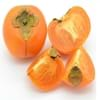Health Benefits
Cancer prevention, Heart care, Heat stroke treatment, Improves eye vision, Weight loss properties
Anti-oxidant properties, Boosts immune system, Skin rejuvenation, Strengthening of bones
General Benefits
Anti-inflammatory properties, Boosts immune system, Cures cough, Digestive aid, Fights against infections, Improves blood circulation
Antiseptic properties, Cures headache, Removes waste from kidney
Skin Benefits
Anti-aging benefits, Brightens and lightens complexion, Reduces wrinkles
Hydrates skin
Hair Benefits
Promotes longer and healthier hair, Protects hair
Good conditioner
Allergy Symptoms
Abdominal pains, Anaphylaxis, Inflammation
Chest pains, Rhinitis, Wheezing
Side Effects
Diarrhoea, Might affect blood pressure level
Unknown
Best Time to Eat
Along with meal, As a snack in the late afternoon, Don't consume at night and before bed, Morning time (before lunch)
As a snack in the late afternoon, Don't consume at night and before bed, Eat the fresh ones, avoid mixing with any other foods, don't eat after meal., Morning time (before lunch)
Vitamin B5 (Pantothenic Acid)
Not Available
Vitamin C (Ascorbic Acid)
Vitamin K (Phyllochinone)
Calories in Fresh Fruit with Peel
Calories in Fresh Fruit without Peel
Not Available
Not Available
Calories in Frozen Form
Not Available
Calories in Canned Form
Not Available
Calories in Jam
Not Available
Calories in Pie
Not Available
Type
Berry, Tree fruit
Tree fruit, Tropical
Season
Autumn, Winter
Early summer, Early winter, Late fall, Late spring
Varieties
Fuyu, Jiro, Gosho, Suruga, Hiratanenashi, Hachiya, Aizumishirazu, Yotsumizo, Yokono, Costata, Ormond and Tamopan
Rongrien, Chompu, Rapiah, Bingjai and Lebak Bulus
Color
Orange, Red, Yellow
Coral red, Yellow
Inside Color
Orange
Greyish-white
Origin
Burma, China, India, Japan
Unknown
Soil Type
Sandy loam, Well-drained
Clay, Loam
Climatic Conditions
Can tolerate wide range of climates
Humid
Facts about
- Unripe persimmons contain lots of tannin which is used to brew sake & to preserve wood in Japan.
- A small non-edible fruit of persimmon tree is crushed with water, the solution is painted on paper & used to repel mosquitoes.
- Oils extracted from its seeds is used to make soaps and candles.
- 'Rambut' means hairy in Malay.
- It makes the best hair mask.
- Seeds are edible and healthy too.
Spirits
Not Available
Yes
Cocktails
Not Available
Yes
Top Producer
China
Thailand
Other Countries
Azerbaijan, Brazil, Israel, Italy, Japan, Pakistan
Africa, India, Indonesia, Malaysia, Philippines, Sri Lanka
Top Importer
United States of America
Singapore
Top Exporter
Japan
Thailand
Botanical Name
Diospyros kaki
Nephelium lappaceum
Synonym
Not Available
Rambota
Subkingdom
Tracheobionta
Tracheobionta
Division
Magnoliophyta
Tracheophyta
Class
Magnoliopsida
Magnoliopsida
Subclass
Dillenhidae
Rosidae
Order
Ericales
Sapindales
Family
Ebenaceae
Sapindaceae
Genus
Diospyros
Nephelium
Species
D. kaki
N. lappaceum
Generic Group
Not Available
Not Available
Compare Japanese Persimmon and Rambutan
It is important compare Japanese Persimmon and Rambutan as both the fruits have a different nutritional value. Their comparison can be done on the basis of their vitamin and mineral content, calories, benefits as well as characteristics, making it easier for us to choose the best fruit for our diet. Their general health benefits are as follows:
Japanese Persimmon Benefits: anti-inflammatory properties, boosts immune system, cures cough, digestive aid, fights against infections and improves blood circulation.
Rambutan Benefits: antiseptic properties, cures headache and removes waste from kidney.
Fruits are also used as a remedy for various hair problems. The hair benefits of Japanese Persimmon are: promotes longer and healthier hair and protects hair and hair benefits of Rambutan are: good conditioner. Some fruits are known to cause allergic reactions. The allergy symptoms of first fruit are: abdominal pains, anaphylaxis and inflammation and the symptoms of second fruit are: chest pains, rhinitis and wheezing. Get sorted Japanese Persimmon vs Rambutan comparison with the help of fruit comparison tool by fruitvs.com.









